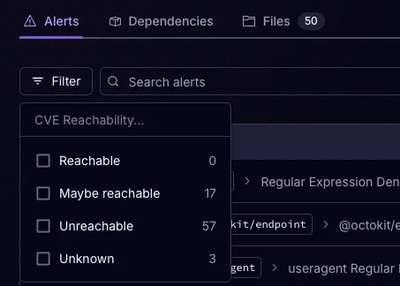
Product
Announcing Precomputed Reachability Analysis in Socket
Socket’s precomputed reachability slashes false positives by flagging up to 80% of vulnerabilities as irrelevant, with no setup and instant results.
range-slider-input
Advanced tools
A lightweight (~2kB) library to create range sliders that can capture a value or a range of values with one or two drag handles
A lightweight (~2kB) library to create range sliders that can capture a value or a range of values with one or two drag handles.
:sparkles: Features
:warning: It is recommended that you upgrade from v1.x to v2.x! What's new and what's changed in v2.x?
npm
npm install range-slider-input
Import the rangeSlider constructor and the core CSS:
import rangeSlider from 'range-slider-input';
import 'range-slider-input/dist/style.css';
CDN
<script src="https://cdn.jsdelivr.net/npm/range-slider-input@2.4/dist/rangeslider.umd.min.js"></script>
or
<script src="https://unpkg.com/range-slider-input@2"></script>
The core CSS comes bundled with the jsDelivr and unpkg imports.
import rangeSlider from 'range-slider-input';
import 'range-slider-input/dist/style.css';
const rangeSliderElement = rangeSlider(element);
rangeSlider(element, options = {})Returns an object of functions that can be called to read or write the properties initially set by options.
elementoptionsObject that specifies the characteristics of the range slider element with the following available properties:
| Property | Type | Default value | Description |
|---|---|---|---|
min | number | 0 | Number that specifies the lowest value in the range of permitted values. Its value must be less than that of max. |
max | number | 100 | Number that specifies the greatest value in the range of permitted values. Its value must be greater than that of min. |
step | number / string | 1 | Number that specifies the amount by which the slider value(s) will change upon user interaction. Other than numbers, the value of step can be a string value of any.From MDN, A string value of |
value | number[] | [25, 75] | Array of two numbers that specify the values of the lower and upper offsets of the range slider element respectively. |
onInput | function | NOOP | Function to be called when there is a change in the value(s) of range sliders upon user interaction or upon calling min(), max(), step(), value() or orientation().Usage: (value, userInteraction) => {}value holds the current lower and upper values in an array and userInteraction is a boolean value which is true if the value is changed upon user interaction. |
onThumbDragStart | function | NOOP | Function to be called when the pointerdown event is triggered for any of the thumbs. |
onThumbDragEnd | function | NOOP | Function to be called when the pointerup event is triggered for any of the thumbs. |
onRangeDragStart | function | NOOP | Function to be called when the pointerdown event is triggered for the range. |
onRangeDragEnd | function | NOOP | Function to be called when the pointerup event is triggered for the range. |
disabled | boolean | false | Boolean that specifies if the range slider element is disabled or not. |
rangeSlideDisabled | boolean | false | Boolean that specifies if the range is slidable or not. |
thumbsDisabled | boolean[] | [false, false] | Array of two Booleans which specify if the lower and upper thumbs are disabled or not, respectively. If only one Boolean value is passed instead of an array, the value will apply to both thumbs. |
orientation | string | horizontal | String that specifies the axis along which the user interaction is to be registered. By default, the range slider element registers the user interaction along the X-axis. It takes two different values: horizontal and vertical. |
Object of functions that can be called to read or write the properties initially set by the options parameter. Available functions:
min(), max(), step(), value() and orientation()These are simple getter and setter functions. So, while calling these functions, if a parameter is supplied, the corresponding values will be set, and if a parameter is not supplied, the corresponding values will be returned.
E.g. Calling step() will return the step value, and calling value([0, 0.5]) will set the lower and upper offsets to 0 and 0.5 respectively.
disabled(), rangeSlideDisabled()The default parameter is set to true. So, if they are called without a parameter, they will set the corresponding values to true.
Thus, calling disabled() or disabled(true) will set options.disabled = true and calling disabled(false) will set options.disabled = false.
thumbsDisabled()The default parameter is set to [true, true]. So, if it is called without a parameter, it will disable both thumbs. Example uses:
// thumbs -> lower upper
// ----- -----
thumbsDisabled() // disabled disabled
thumbsDisabled(true) // disabled disabled
thumbsDisabled(false) // enabled enabled
thumbsDisabled([]) // enabled enabled
thumbsDisabled([false]) // enabled enabled
thumbsDisabled([true]) // disabled enabled
thumbsDisabled([true, false]) // disabled enabled
thumbsDisabled([false, true]) // enabled disabled
thumbsDisabled([false, false]) // enabled enabled
thumbsDisabled([true, true]) // disabled disabled
currentValueIndex()Returns the index (0 for the lower value and 1 for the upper value) of the value which is currently being modified.
Returns -1 when the slider is idle.
removeGlobalEventListeners()Removes the global event listeners. It should be called when removing the range slider element from the DOM dynamically.
<div class="range-slider"><!-- range slider element -->
<input type="range" /><!-- hidden -->
<input type="range" /><!-- hidden -->
<div class="range-slider__thumb" data-lower></div>
<div class="range-slider__thumb" data-upper></div>
<div class="range-slider__range"></div>
</div>
<div class="range-slider"></div> is the wrapper element that was used to instantiate the range slider initially and is added with a CSS class named range-slider.
<input type="range" /> elements are used to set values and are hidden.
<div class="range-slider__thumb"></div> elements are the slidable thumbs replacing the original thumbs from the <input type="range" /> elements.
<div class="range-slider__range"></div> element fills up the space between the thumbs.
element-selector {
/* CSS for the wrapper element */
}
element-selector[data-disabled] {
/* CSS for disabled range slider element */
}
element-selector .range-slider__range {
/* CSS for range */
}
element-selector .range-slider__range[data-active] {
/* CSS for active (actively being dragged) range */
}
element-selector .range-slider__thumb {
/* CSS for thumbs */
}
element-selector .range-slider__thumb[data-lower] {
/* CSS for lower thumb */
}
element-selector .range-slider__thumb[data-upper] {
/* CSS for upper thumb */
}
element-selector .range-slider__thumb[data-active] {
/* CSS for active (actively being dragged) thumbs */
}
element-selector .range-slider__thumb[data-disabled] {
/* CSS for disabled thumbs */
}
Refer to the style.css file to know more about styling the range slider element and its children.
React: react-range-slider-input
MIT © Utkarsh Verma
FAQs
A lightweight (~2kB) library to create range sliders that can capture a value or a range of values with one or two drag handles
The npm package range-slider-input receives a total of 1,970 weekly downloads. As such, range-slider-input popularity was classified as popular.
We found that range-slider-input demonstrated a not healthy version release cadence and project activity because the last version was released a year ago. It has 1 open source maintainer collaborating on the project.
Did you know?

Socket for GitHub automatically highlights issues in each pull request and monitors the health of all your open source dependencies. Discover the contents of your packages and block harmful activity before you install or update your dependencies.

Product
Socket’s precomputed reachability slashes false positives by flagging up to 80% of vulnerabilities as irrelevant, with no setup and instant results.

Product
Socket is launching experimental protection for Chrome extensions, scanning for malware and risky permissions to prevent silent supply chain attacks.

Product
Add secure dependency scanning to Claude Desktop with Socket MCP, a one-click extension that keeps your coding conversations safe from malicious packages.